
Media of Digestive Care, Laparoscopic & GI Surgeries
Precautions After a Laparoscopic Gallbladder Surgery
Laparoscopic gallbladder surgery (cholecystectomy) removes the gallbladder and gallstones through several small cuts (incisions) in the abdomen. The surgeon inflates patient’s abdomen with air or carbon dioxide in order to see clearly.
Sometimes patients are nauseated after waking from the anesthesia. This sensation usually passes. If it does not, medication can be given to relieve it.
Postoperative pain can usually be controlled with over-the-counter pain relievers. Some patients may need a stronger, prescription analgesic.
The incisions are covered by small adhesive bandages that can be removed in about 5 days and the stitches dissolve over time. The area must be kept dry until the wound begins to heal and sponge baths are recommended for the first day or two.
Recovery from the laparoscopic procedure is quicker than from the open procedure. As the anesthesia wears off, and once vital signs stabilize, the nurse offers the patient ice chips. If ice is tolerated, water and other clear liquids are offered. Once liquids are tolerated, patients can eat a light meal and the IV is removed.
How is it different from an open surgery?
Recovery from open surgery is not as rapid. Patients experience pain at the incision site and a narcotic pain reliever is usually required for the first day or two. The patient may not be able to eat until the morning after surgery. The intravenous is left in until food and fluids are taken and tolerated.
Patients are usually able to get out of bed by the next morning. It is important to get up and walk as soon as possible to help blood circulation return to normal and to avoid complications such as blood clots. The hospital stay generally lasts 3 to 7 days and it usually takes about 3 weeks to fully recover. This procedure leaves a large abdominal scar, which may fade over time…
Diet instructions you need to know after the surgery
When you consider about your diet after the gallbladder surgery. No need to follow a special diet after having the surgery, as the gallbladder isn’t essential for digestion. You can usually start eating normally a few hours after your operation, although you’ll probably prefer to eat small meals to start with.
You may have been advised to follow a low-fat diet for several weeks before surgery, but this doesn’t need to be continued afterward. Instead, you should aim to have a generally healthy, balanced diet (including some fats).
Conclusion
Even Though cholecystectomies are safe, but complications can develop. The main disadvantage of laparoscopic surgery has increased the risk of injury to the bile duct, which connects the gallbladder and the liver. This rarest complication can cause serious liver damage.
If you experience side effects from the surgery – including indigestion, bloating, flatulence or diarrhea – it may help to make some small adjustments to your diet such as
- Avoid drinks containing caffeine – such as coffee and tea,
- Avoid foods that make the problems worse – such as spicy or fatty foods,
- Gradually increase your intake of fibre – good sources of fibre include fresh fruits and vegetables, wholegrain rice, whole-wheat pasta and bread, seeds, nuts, and oats.
Laparoscopic Appendix Surgery(Appendectomy)
Appendicitis is inflammation of the appendix. Laparoscopic Appendectomy or Appendix Removal Surgeryis routinely done at almost all the top hospitals in Mumbai, India. It involves making tiny incisions in the abdomen and removing appendix through it. Laparoscopic Surgeons are extensively trained to do surgeries using laparoscope (a thin telescope)
Dr Ashish Chaudhary is laparoscopic & Colorectal Surgeon at GB Multicare Hospital with more than 17 years’ experience in Laparoscopic Surgery.
If appendix becomes infected it must be surgically removed (emergency appendicectomy or appendectomy) before it perforates (burst) and spreads the infection to entire abdomen (peritonitis). Burst Appendix can be dangerous and may lead to death.
Symptoms & Diagnosis of Appendicitis
What Are the Symptoms of Appendicitis?

Following are usual symptoms of appendicitis-Pain in right lower Abdomen- may worsen during walking or coughing, fever usually occur within several hours, loss of appetite, nausea vomiting, constipation chills/shaking – Appendicitis is a surgical emergency.
How is Appendicitis Diagnosed?
It is essentially a clinical diagnosis. There is no laboratory test or radiological test yet that is 100% diagnostic. USG and CT scan done by a good radiologist has an accuracy of greater than 90% but it may be negative. Diagnostic laparoscopy has a sensitivity and specificity of 100%.
Treatment Options Available for Appendicitis
The ideal treatment is surgical removal. Mild appendicitis may sometimes be cured with medicine(antibiotic), but removal of appendix at later date to prevent recurrence may be done which is called interval appendectomy. More serious cases are treated with emergency surgery to remove appendix. Surgeons use either an open or laparoscopic appendectomy surgery to remove appendix.
What is Laparoscopic Appendectomy?
In general anaesthesia a small incision is made at the naval and thin tube carrying the video camera is inserted .The surgeon inflates the abdomen with CO2 to provide room for surgery to be performed .Next two instruments are inserted. The instruments clears fat around the appendix, controls bleeding and ligate the base of appendix. They help to cut the appendix and it is then removed from tiny naval incision.
Preparation & Recovery for Laparoscopic Appendectomy
Preparation for Laparoscopic appendix surgery
One should not eat or drink within 6-8 hrs of surgery.
Patient can be admitted on day of surgery in the morning or one day in advance. Anaesthesia fitness is given by anaesthetist. Laparoscopic appendectomy operation is typically over in about 45 minutes to an hour, depending upon the operative findings.
Recovery after Laparoscopic Appendectomy,
Once the operation is over patient is kept in the recovery room where a strict watch is kept.
Post appendicectomy you patient will be kept fasting for a minimum period of 6 hours. The period of fasting may be increased depending upon how severely inflamed the appendix was. During the period of fasting IV antibiotics, pain killers and IV fluids are given. Once oral intake is resumed, depending upon bowel movements full normal diet can be resumed.
What are the Benefits of Laparoscopic Appendectomy?
- Less post-operative pain
- Faster recovery time and return to normal activity
- Shorter hospital stay
- Minimally sized incision
But every Patient may not be fit to Undergo Laparoscopic Appendectomy.
Patient with cardiac disease and COPD are usually not good candidates for laparoscopic appendix surgery. Also patient on radiotherapy and immunocompromised patients cannot undergo this procedure.
Appendix operation cost in Mumbai
Cost of Laparoscopic Appendix operation in Nagpur varies with the hospital set up and your exact diagnosis. In a small nursing home cost may be INR 30,000/- to 70,000 approx. Whereas cost in few top hospitals in Nagpur may be INR 70,000/- to 80,000/- approx./.
Laparoscopic Fundoplication Surgery Mumbai
Medical Gastroenterologist may refer a patient of GERD or Heart Burn or hiatal hernia to a GI Surgeon for operation when medical treatment fails. With the advent of laparoscopic surgery in India, Laparoscopic Fundoplication Surgeryor Laparoscopic Anti-Reflux Surgery or Nissenfundoplication is best surgical option available for resistant GERD and large Hiatus hernias.
Dr Ashish Chaudhary is senior laparoscopic surgeon with 17 years’ experience in the field and fellowship in advance laparoscopic surgery. He is among those surgeons who perform Laparoscopic fundoplication surgery in Nagpur.
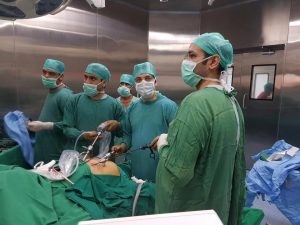
What is Heart Burn or GERD ?
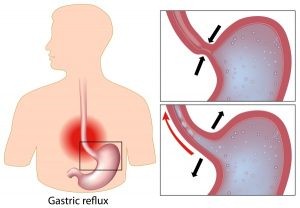
The lower end of the esophagus (LES) works as a one-way valve allowing food to pass from the food pipe to the stomach but prevents the highly acidic stomach juices from going back into the food pipe (reflux).
When LES is weak or lax, it results in reflux of stomach acids causing stinging, burning sensation in the throat and chest, a condition known as GERD (Gastro-Esophageal Reflux Disease)Repeated reflux may lead to inflammation and damage to the esophagus. Some individuals are predisposed to LAX LES. Bad diet, smoking, alcohol, or certain body postures – all can lead to GERD.
What is Hiatus Hernia?
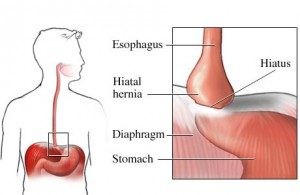
The esophagus passes from the chest to the abdomen through an opening in the diaphragm (esophageal hiatus). This opening is usually just adequate for passage of the esophagus. However, patients that have a hiatal hernia have an enlarged opening. A hiatal or diaphragmatic, hernia occurs when the lower part of the esophagus and a portion of the stomach slide up through this esophageal hiatus into chest cavity.
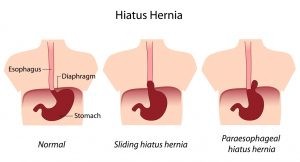
There are four different types of hiatal hernias and sliding hernia is the most common of the four representing more than eighty-percent of all hiatal hernias
Sliding hiatal hernias are those in which the junction of the esophagus and stomach, and part of the stomach protrude into the chest.
Para-esophageal hernias are hernias in which the gastro-esophageal junction stays where it belongs but part of the stomach passes or bulges into the chest beside the esophagus. The para- esophageal hernias themselves remain in the chest at all times and are not affected by swallows.
Symptoms & Diagnosis Of Hiatal Hernia
Symptoms:
- Heartburn – 30-60 minutes after eating
- Regurgitation – more with lying flat
- Excessive belching
- Aspiration – reflux of stomach contents into the airway
- Chronic cough or Asthma – because of chronic aspiration
- Mid Chest Pain/li>
- Difficulty or pain with swallowing
- Symptoms of obstruction
Diagnosis:
- Hiatal hernias are diagnosed incidentally when an upper gastrointestinal x-ray or endoscopy is done.
- Chest X-ray:
- Esophagogram (Barium UGI)
- Upper GI Endoscopy (EGD)
- Esophageal Manometry
What are the Treatment Options for GERD ?
Mild GERD may be treated with modified diet, quitting smoking and drinking, regular exercises and better sleeping habits. Along with life style modifications, medicines such as antacids and anti reflux medicines can be prescribed.
When all that fails, then the next logical step is surgery.
Large para esophageal hernias causing symptoms requires surgery. Repair will help prevent complications such as bleeding, intestinal disruption, strangulation.
Treatment of sliding hiatal hernias is usually the same as for the GERD.
Surgical Procedure for GERD /hiatal hernia
Laparoscopic Fundoplication or laparoscopic anti reflux surgery is best surgical option available for large hiatal hernia and for failed medical treatment of GERD.
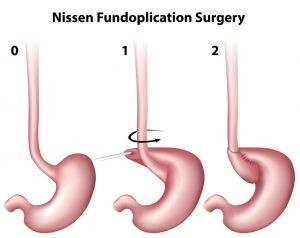
The stomach and lower esophagus are placed back into the abdominal cavity. Hernia defects greater than 5 cm. are buttressed with mesh which significantly decreases the recurrence rate.
The opening in the diaphragm (hiatus) is tightened and the stomach is stitched in position to prevent reflux.
The upper part of the stomach (fundus) may be wrapped around the lower end of esophagus (Fundoplication) to prevent reflux.
Advantage of Laparoscopic Fundoplication surgery
Open surgery involves a large incision, a week or more of hospital stay and pain. However, with advanced laparoscopy the same procedure can be done as a day-care surgery with only small holes over the stomach, no pain and it is much safer than the open surgery having a faster recovery to normal activities.
Due to obesity or pre-existing conditions, the laparoscopic method may not be suitable for few patients. During the surgery, the Surgeon may take a decision to do the “open procedure,” strictly based on the safety of the patient.
Preparation for Laparoscopic Anti -Reflux Surgery
Blood Work, Medical Evaluation, Chest X-Ray and an ECG.
- Drink clear liquids, for 2-3 days prior to surgery.
- After midnight the night before the operation, you should not eat or drink anything
- Drugs such as aspirin, blood thinners, anti-inflammatory medications and Vitamin E are to be stopped a week prior to surgery.
- Quit smoking
Recovery After Laparoscopic Fundoplication Surgery
- Patients are started on clear liquids the next morning and are discharged in the afternoon.
- Soft food is given for 4-6 weeks after surgery.
- Patients are encouraged for early ambulation and light activity after surgery.
- Post-operative pain is generally mild for which pain medication may be given.
- Anti-reflux medication is usually not required after surgery.
Enquire about Laparoscopic Gall Bladder operation (Laparoscopic Cholecystectomy) at GB Multicare Hospital Nagpur- at 9823775733 online enqiry
Laparoscopic Hernia Repair Surgery in Mumbai
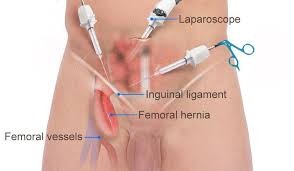
Limitations of open hernia surgery namely long period of rest (average 6 weeks) and chance of hernia coming back (recurrent hernia) led to rapid popularity of Laparoscopic Hernia Surgery all over the world and in India. Laparoscopic Tension Free Hernia Repair means less pain, less hospital stay, faster recovery and less chances of recurrence.
Dr Ashish Chaudhary Senior Specialist is expert at GB Multicare Hospital Nagpur for all types of simple and complex Hernia including recurrent Hernia. He has performed thousands of Tension Free Laparoscopic (key Hole) Hernia Repair with use of best quality mesh to maximize success rate, rapid recovery and quick return to work.
Is surgery must for Treatment of Hernia?
Surgery is the only treatment option for Hernia. It is better to undergo surgery before symptoms worsen or before complication starts. The possible complications include obstruction or strangulation which may be life threatening.
Cost & benefit of Laparoscopic Hernia Surgery
Cost of hernia surgery in Nagpur
Exact estimation of cost of hernia operation cannot be given till a doctor examines the patient personally as it depends so many factors like the type of hernia, type of surgery most suitable, type of mesh and different hospitals. Cost of Laparoscopic Hernia surgery by best doctor for Hernia Surgery in Nagpur is approximately 80,000/ to 1, 00,000/- excluding mesh and tracker (Used to fix the mesh) charges.
Nagpur is rapidly advancing in medical care and our best Laparoscopic Hernia Specialist Surgeons are offering best services at reasonable cost.
Benefits of Laparoscopic Hernia surgery
- Small incisions
- Less post-operative pain
- Earlier return to work
- Shorter hospital stay
- Positioning of the mesh on the inside of the defect is mechanically better than when placed on the outside as in the non-keyhole operation
- Recurrent hernias are much easier as approached from the inside
- Hernias on both sides can be repaired through the same three holes as opposed to open surgery where separate incision is to be given on other side
How Laparoscopic Hernia Operation is Done?

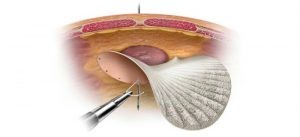
- Tiny incisions are placed on the abdomen.
- The abdomen is inflated with harmless gas (carbon di oxide) to create space to operate. The laparoscope with attached camera and special long instruments are inserted through these incisions.
- Surgeon performs the procedure watching high resolution images of the patient’s abdomen on the monitor.
- Hernia contents are pulled back in rather than pushed in from outside as is done in an ‘open’ operation and defect repaired with mesh from inside.
- Following the procedure, the small abdominal incisions are closed with a stitch or two or surgical tap or glue can be applied.
What to Expect After Hernia Surgery?
Activity:
- Once patient is awake walk is encouraged
- Routine activities like car driving can be resumed one week after keyhole repair and 2 weeks after open repair
- Bath can be taken daily if advised
- Avoid bending forward frequently
- Avoid strenuous work and lifting weight over 5kg, for 2 months
Diet:
- Normal diet and plenty of liquids are advised. Avoid diet which may cause cough and cold.
Pain:
- Slight pain may be experienced during the first 24 to 48 hours. Painkillers are prescribed for first 2 days
Hospital Stay & Rest:
- Most patient may go home same day of the surgery (day care surgery)
Normal rest at home for 2-3 days, you may go back to work within few days after laparoscopic surgery repair.
- Heavy weight lifting is to be avoided for approx. 2 weeks after Laparoscopic Hernia repair.
- Some swelling around incision and bluish discoloration is normal in groin hernias, which can be up to scrotum.
Types Of Hernia we treat
Hernia is a bulge in the abdomen due to protrusion of contents of the abdomen through a normal or abnormal opening.
Types of Hernia
- Inguinal hernia
- Umbilical hernia
- Incisional hernia
- Femoral hernia
- Epigastric Hernia
- Hiatus Hernia
- Strangulated Hernia
- Obstructed Hernia
- Complex Hernia
- Recurrent Hernia
Types Of repair For Inguinal/Umblical/Incisional Hernia
- Simple Tension Free proline mesh repair of Hernia (Leichenstein’s Hernia Repair)
A Polypropylene mesh is used to seal the defect. - Laparoscopic Repair Transabdominal preperitoneal hernioplasty (TAPP) our surgery video link a mesh is placed inside the abdominal wall whereas totally extraperitoneal mesh repair (TEP)our surgery video link is done extraperitoneally.
These are technically much more demanding procedures and should be performed by an experienced Hernia Specialist. - 3-D Mesh Hernia Repair most advanced method of hernia repair and it covers the hernia defect from 3 sides- above, below and centre. It is a tension-free repair in which a Polypropylene mesh is used.
- Complex Hernia Repair with Abdominal wall Reconstruction: multiple previous failed hernia repairs, for very large hernia, advanced hernia repair techniques may be required along with reconstruction of the abdominal wall and then reinforcement with mesh.
Enquire about laparoscopic hernia repair at GB Multicare Hospital Nagpur- at 9823775733 online enqiry or or Book appointment
Anal Fistula Treatment in Nagpur (Fistula –in-Ano)
Surgery is necessary to cure an anal fistula. Fistulectomy is treatment of choice in fistula surgery. Fistulotomy, fistula plug and fibrin glue are some of the options for Fistula treatment.
In some patients with high fistula and with recurrent or complex fistula, there is a risk of potential damage to the anal sphincters during fistula procedures.
Therefore with a goal to minimize injury to anal sphincter a number of newer sphincter-saving procedures with faster recovery are being used at our Colorectal Clinic such as –
- LIFT (Ligation)
- VAAFT (Video Assisted Anal Fistula Treatment)
- LASER fistula Treatment
What is Anal Fistula?
Fistula-In -Ano is a tunnel like track in the area surrounding anus (Perianal area) that connects to an internal opening in the anus. It may cause pain, and bleeding and pus discharge during passing stools.
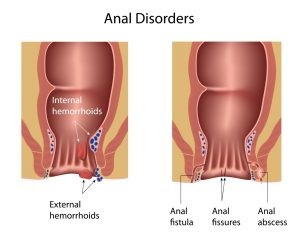
Symptoms of anal abscess or fistula
Patient with anal abscess will usually have pain and swelling around the anus. There may be fevers and chills. Once fistula is farmed there may be irritation of the skin around the anus (perianal area), bleeding and discharge of pus.
Diagnosis of Anal abscess and fistula
Digital rectal examination is important step in the evaluation anal fistula.
Sigmoidoscopy may be required to locate the internal opening and to check for any other issue.
Sometimes colonoscopy may be done for patients with recurrent anal fistula with symptoms of inflammatory bowel disease.
Endoanal ultrasonographyis useful in the total assessment of anal fistula.
Fistulography and magnetic resonance imaging may be useful for complex recurrent anal fistula.
LASER treatment of Anal Fistula (FiLaC)
Our Colorectal surgeon is performing new fistula treatment using diode Laser – Fistula LASER Closure (FiLaC) in Mumbai. It is safe, effective minimally invasive and sphincter saving procedure. It usually takes approximately 15 min time.
Steps:
- Hydrogen peroxide or mythelene blue is injected from external opening to identify Internal opening of fistula.
- Fistula tract is debrided with curate.
- Through guide wire a plastic hollow 14F catheter is inserted in tract.
- Radial-emitting disposable laser fibre is inserted into the catheter with its tip emerging at the internal opening.
- Diaode LASER is used, fibre delivers laser energy homogenously and the tract is closed. Slowly it is withdrawn
Advantage
- It doesn’t affect continence function.
- Less hospital stay as compared to endorectal advancement flap or LIFT.
Video Assisted Anal Fistula Treatment (VAAFT)
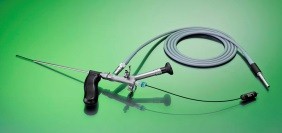
Video-assisted anal fistula treatment (VAAFT) is a new minimally invasive and sphincter-saving endoscopic treatment for complex fistulas.
Fistula tract and internal fistula is localized using fistuloscope (endoscope) inserted through external opening and under direct vision fistula tract is destroyed from inside and closure of the internal opening is done by stapling or suturing or cutaneous-mucosal flap.
Advantage of VAAFT
- Less pain, early recovery
- Very Low risk of incontinence (sphincter injury)
LIFT (ligation of intersphincteric fistula tract)
In Life technique after identification of internal sphincter, an incision is made at fistula tract and infected tissue is removed through inter-sphincteric approach. Defect is sutured.
Advantage of LIFT
- High success rate
- Preservation of continence function of sphincter
To enquire what is best treatment for Anal Fistula repair and cost of LASER treatment of fistula at GB Multicare Hospital Nagpur- at 9823775733 online enqiry or or Book appointment
Anal Fissure
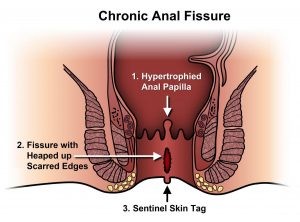
Anal Fissure is Common Cause of Visit to Our Proctologist at Colorectal Clinic Vashi, Navi Mumbai. Fissure in Ano is a tear or cut in the linings of anus.
Fissures typically cause severe pain and bleeding while passing stool (faeces) and often confused with haemorrhoids or cancer. Delay in diagnosis causes acute fissure becoming chronic and thus more difficult to treat.
Majority of anal fissure does not require surgery; surgery is advised if home care and medical treatment (read below) fails.
Get diagnosed by our Fissure specialist click to call 9823775733
Causes of Anal Fissure
- Most common cause is trauma to anus while passing stool in constipation or repeated diarrhoea.
- Occasionally rectal thermometer, endoscope, enema tip can be the reason of trauma
- Other rare causes: crohn’s disease, anal cancer, tuberculosis, viral infections (syphilis, herpes, cytomegalovirus, HIV) Biopsies of these fissures are mandatory.
Symptoms & Diagnosis of Anal Fissure
Symptoms:
- Severe Pain at anal area that worsens on bowel movement
- Bleeding while passing stool (more common in infants)
- Anal Itching
Diagnosis:
Careful history of pain and bleeding while passing stool, usually suggests presence of anal fissure. Visible fissure in the midline of anus confirms diagnosis.
If rectal bleeding is present rigid or flexible sigmoidoscopy is usually done at our one stop colorectal clinic at Vashi, Navi Mumbai. In a patient over 50 years of age or with a family history of colon cancer a colonoscopy is to be performed.
Home & Medical Treatment of Anal Fissure
An acute fissure is typically managed with non-operative treatments and over 90% will heal without surgery. Often treating constipation or diarrhea can cure a fissure.
General Treatment and Home Remedies for Anal Fissure –
- Drinking plenty of water (8-10 glasses)
- High fibre diet
- Over the counter fibre supplements (25-35 grams of fibre per day)
- Avoiding food that may not be digested easily like -nuts, popcorn
- regular exercise
- Use of moist tissues or shower spray is often better alternative to toilet paper after bowel movements.
- hot sitz both -(sitting in a tub of Luke warm water for 20 min)
Medical Treatment for Anal Fissure –
- Stool softener containing (natural psyllium husk)
- Laxatives
- Topical/local anaesthetic gel to reduce pain
- Topical ointment for relaxation of sphincter, headache is a side effect.
- Topical Ca channel blockers are effective alternative in breast feeding women where should not be used.
Injection & LASER For Anal Fissure
- Treatment works by temporary paralysing muscles of internal sphincter. Toxin injection into internal anal sphincter is effective and and it can berepeated.
- LASER treatment for anal fissure

Anal Fissure Surgery in Nagpur
Surgery is indicated when medical management and life style modification fails to heal an anal fissure. Chronic fissure present for more than 6 weeks may require a biopsy to rule our crohns or cancer.
He offers Lateral internal sphincterotomy, flaps surgery and LASER treatment for Anal Fissure.
Lateral Internal sphinterotomy –
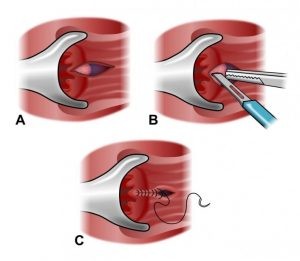
Standard Task Force of the American Society of Colon and Rectal Surgeons has recommended partial lateral internal sphincterotomy as the technique of choice for the anal fissures surgery.
In this procedure less than a third of sphincter is cut at the level of fissure. It is extremely effective procedure. If a sentinel pile is present, it may be removed to promote healing of the fissure.
Anoderm or rectal advancement flaps – if fissure does not heal by any means, than ANAL FISSURE is removed and repaired using a flap. This is particularly done for chronic painless fissures where spam is not the cause.
Recovery & Preventing recurrence
Recovery after Anal fissure surgery
Complete healing with medicines or surgical treatments can take up to approximately 6-10 weeks. However, patient is relieved of acute pain after surgery within a few days. Majority of patients can resume work and daily activities in a few days.
cPreventing recurrence of Anal fissure:
- Avoid constipation by drinking plenty of water and high fiber diet
- Avoid supressing natural urge to pass stool
- Develop regular bowel habit
- Avoid straining at stool
- Avoid anal intercourse
Can fissure cause colon cancer?
No, fissure cannot lead to colon cancer, however careful evaluation and proper diagnosis by colorectal surgeon is required as other conditions can cause similar symptoms as anal fissure.
Find Out More About Anal Fissure LASER Treatment including cost estimation at our one stop colorectal hospital at GB Multicare Hospital Nagpur- at 9823775733 online enqiry or or Book appointment
One Stop ColoRectal –Piles Clinic in Mumbai
Treatment of piles without any surgery is possible if piles are diagnosed in early stages. Less severe piles can be treated by changes in diet, medicines and Painless Minimally Invasive Surgery/Procedures for piles at one stop colorectal clinic/piles clinic by best doctor for piles. Major surgery for haemorrhoids/ Piles /Bavasir/Mulvyadh can be avoided with advanced treatment.
Advance Painless Piles Treatment: Best piles treatment
- DGHAL (ligation Of Piles)
- Stapler surgery for Piles (MIPH)
- LASER Procedure for Piles
Advantages of Painless Piles Treatment:
- No Cutting /minimally Invasive
- Same Day surgery/Short Hospital Stay
- Faster recovery/early return to work
- Excellent Success
DG HAL (Ligation Of haemorrhoid)
Doppler Guided Haemorrhoidal Artery Ligation (DG HAL) and Recto-Anal Repair (HAL RAR) or Hemorrhoid Artery Ligation operation (HALO) for piles is a FDA approved operation designed to eradicate piles/Mulvyadh/Bavasir without the need for cutting.

DG-HAL Technique
By ultrasonic blood flow detector (Doppler) Piles surgeon identifies the blood vessels supplying the piles and ties by a suture around it through a small window in the device.
Tying off arteries that feed piles causes them to shrink with resolution of most bleeding and protrusion. Over next few days symptoms resolve completely.
Through the window of device Recto-Anal- Repair (R.AR.) can also be done to reposition the prolapsed tissue.
Benefits of DG-HAL & HAL-RAR
- No cutting and no open wounds
- Short procedure time
- Back to work the next day
- Very high success rates worldwide
Stapler Hemorrhoidectomy/MIPH
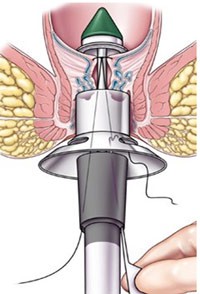
Minimally invasive Stapler hemorrhoidectomy (MIPH) uses a stapling device.
The mucosa above the dentate line, with piles mass is excised and stapled with the stapler gun, thus taking care of bleeding and prolapse – the two major components of piles. The titanium staples cut and seal simultaneously, thus causing minimal bleeding and as the cut line is above the nerves, there is reduction in post-operative pain.
Advantages of Piles Stapler Surgery (MIPH)
- Less pain
- Minimal scarring
- Fewer complications
- Less blood loss
- Reduced risk of infection
- Shorter hospital stay
- Faster recovery
LASER Treatment For Piles
LASER treatment for piles causes vaporization or excision with accuracy and precision. Laser beam allows operating in a bloodless field without pain sensation because of sealing of small nerves and blood vessels.
Advantages of LASER Treatment of Piles:
- Less discomfort
- Less medication
- Faster healing
- Very short hospital stay
Piles Treatment cost in Nagpur
Cost of piles operation depends on degree of piles, type of piles treatment chosen for individual patient and type of hospital where surgery is performed. It varies from INR 50,000/- to 1 lakh.
Causes, Symptoms ,Degree & Diagnosis of Haemorrhoids
Piles/ haemorrhoids/bavasir/mulvyadh are dilated and swollen veins in the anal canal, they may form visible swellings. Piles are common reason for blood with stool (rectal bleeding)
Piles are of two types, external and internal.

Causes of haemorrhoids (Piles)?
Causes of piles are constipation, excessive straining during bowel movement, heavy weight lifting, Obesity, Prolonged sitting on the toilet and Pregnancy.
Symptoms of piles
- Bleeding during passing motion
- Protrusion during passing stool
- Lump at anal area
- Anal or lower abdomen Pain
- Itching and irritation at anus
Haemorrhoids can be of four degrees:-

First-degree hemorrhoids: bleed, do not prolapse.
Second-degree hemorrhoids: prolapse and goes back in on their own (with or without bleeding).
Third-degree hemorrhoids: prolapse but can be pushed back by a finger.
Fourth-degree hemorrhoids: prolapse and cannot be pushed back in.
Diagnosis of piles
If there is rectal bleeding or blood with stool one should always visit a general Surgeon or Colo-rectal specialist doctor to rule out certain serious reasons of bleeding.
Piles can be diagnosed simply by Symptoms, per rectal examination by a gloved finger and proctoscopy.
Preparation for Procedure for Piles & recovery
Preparation for Procedure for Piles
- On the day of you will be given enema or suppository for bowel preparation
- You will not be allowed to eat / drink 6 hours prior to surgery
Post-Operative recovery what to expect?
- You may have soft pad in place.
- You will be allowed to drink when you are fully awake
- Usually no pain medication is required
- You may feel the need to defecate frequently throughout the first 24 hours
- There’s usually little or no postoperative bleeding, and return to work within 48 hours
- Diet- Eat diet reach in fiber, drink 8-10 glasses of water
- Activities- You can resume your routine activities and work same day. Avoid driving for 24 hours
